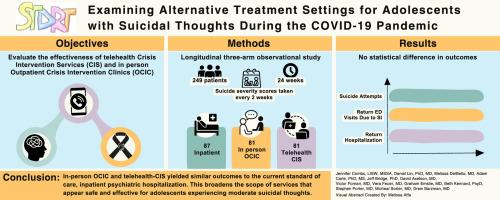Examining Alternative Treatment Settings for Adolescents With Suicidal Thoughts During the COVID-19 Pandemic
引用次数: 0
Abstract
Objective
Suicide is a leading cause of death for adolescents in the United States. Alternative settings to treat suicidal ideation (SI) are needed. Study primary objectives include evaluating the safety and effectiveness of telehealth crisis intervention services (CIS) and in-person outpatient crisis intervention clinics (OCIC) relative to the current standard of care of inpatient psychiatric hospitalization. A secondary aim seeks to assess changes in suicidal ideation, and patient and parent treatment satisfaction.
Method
The study team, consisting of study staff at 4 sites, conducted an observational longitudinal study of patients (12-18 years of age) who were seen in the Emergency Department (ED) for suicidality and were referred to inpatient treatment, in-person OCIC, or telehealth CIS. Primary outcome data, including recurrent ED visits and hospitalizations because of SI, suicide attempts, and life satisfaction, were collected for 24 weeks. All analyses were adjusted for age, sex, and baseline suicidality severity scores. A total of 249 patients were enrolled.
Results
There were no statistically significant differences in suicide attempts, time to first suicide attempt, ED visits, hospitalizations, and life satisfaction among the 3 treatment arms. There was no statistically significant difference in outcomes for treatment satisfaction among the treatment groups.
Conclusion
In this observational study, in-person OCIC and telehealth CIS did not have significantly different outcomes from the current standard of care of inpatient psychiatric hospitalization. This broadens the scope of services that appear to be safe and effective for adolescents experiencing moderate suicidal thoughts. Future research using randomized controlled trials to clarify the causal effect of different interventions is warranted.
Clinical trial registration information
Observational Study to Compare Outcomes of Different Psychiatric Treatment of Suicidal Adolescents (Pre-START); https://clinicaltrials.gov/study/NCT04625686.
Plain language summary
The PreSTART study sought to explore treatment outcomes for adolescents experiencing suicidal thoughts. Inpatient treatment, outpatient crisis intervention centers, and telehealth crisis interventions were explored and compared to evaluate safety and effectiveness over a 24-week period. Results found no statistical difference in recurrent suicidal events or treatment satisfaction among the different treatments.
Diversity Inclusion Statement
We worked to ensure that the study questionnaires were prepared in an inclusive way. The author list of this paper includes contributors from the location and/or community where the research was conducted who participated in the data collection, design, analysis, and/or interpretation of the work.

研究在COVID-19大流行期间有自杀念头的青少年的替代治疗方案
在美国,自杀是青少年死亡的主要原因。需要其他治疗自杀意念(SI)的方法。研究的主要目标包括评估远程医疗危机干预服务(CIS)和面对面门诊危机干预诊所(OCIC)相对于目前精神科住院病人的护理标准的安全性和有效性。第二个目的是评估自杀意念的变化,以及患者和家长对治疗的满意度。方法研究小组由4个地点的研究人员组成,对在急诊科(ED)就诊并转介到住院治疗、现场OCIC或远程医疗CIS的12-18岁患者进行了一项观察性纵向研究。主要结局数据,包括因SI、自杀企图和生活满意度而复发的急诊科就诊和住院,收集了24周。所有分析均根据年龄、性别和基线自杀严重程度评分进行调整。共有249名患者入组。结果3个治疗组在自杀企图、第一次自杀企图时间、急诊科就诊次数、住院次数和生活满意度方面差异均无统计学意义。治疗组间治疗满意度结果差异无统计学意义。结论在这项观察性研究中,现场OCIC和远程医疗CIS与目前精神科住院患者的护理标准没有显著差异。这扩大了对有中度自杀念头的青少年似乎安全有效的服务范围。未来的研究需要使用随机对照试验来澄清不同干预措施的因果关系。自杀青少年不同精神治疗(Pre-START)效果比较观察性研究https://clinicaltrials.gov/study/NCT04625686.Plain语言摘要PreSTART研究旨在探索有自杀念头的青少年的治疗结果。在24周的时间里,对住院治疗、门诊危机干预中心和远程医疗危机干预进行了探讨和比较,以评估安全性和有效性。结果发现,不同治疗方法在自杀事件复发及治疗满意度方面无统计学差异。多样性包容性声明我们努力确保以包容性的方式准备研究问卷。本文的作者列表包括来自研究开展地和/或社区的贡献者,他们参与了数据收集、设计、分析和/或解释工作。
本文章由计算机程序翻译,如有差异,请以英文原文为准。
求助全文
约1分钟内获得全文
求助全文

 求助内容:
求助内容: 应助结果提醒方式:
应助结果提醒方式:


